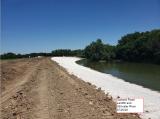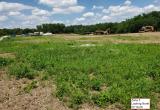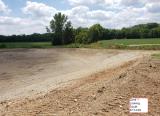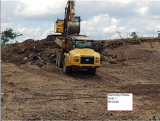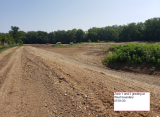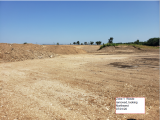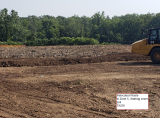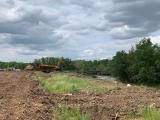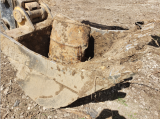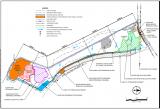Garland Road Landfill Site
August 2020 Update
Riverbank stabilization work continues at the Garland Road Landfill Superfund Site. U.S. Army Corps of Engineers plans on finishing the planting of a vegetative cover in September. The vegetative cover helps stabilize the soil to prevent erosion during rain events.
July 2020 Update
The images below are photos of the work in progress at the Garland Road Landfill Superfund Site. The contractor working for the U.S. Army Corps of Engineers is making good progress, and they strive to complete the current phase of work by this August.
Safety reminder for Stillwater River visitors: For their safety, recreational users of Stillwater River (kayaking, fishing, boating, etc.) should avoid disembarking along the U.S. EPA cleanup site’s portion of the western riverbank. While there is no immediate exposure risk of recreational users of the river to site contaminants, there are physical hazards related to heavy equipment and ongoing work at this active construction site. Warning signs are posted along the river bank as visual markers of the area to avoid.
June 2020 Update
Riverbank Stabilization
Stillwater River riverbank stabilization activities are ongoing and will continue through the summer. These activities include the excavation and regrading of soil along the west bank of the river. As a general precaution, EPA recommends that recreational users of Stillwater River avoid the west bank near the Garland Road Landfill site (south of the Frederick-Garland Road bridge over the Stillwater River) due to the presence of heavy construction equipment working on riverbank stabilization.
Waste Drums Removal
Crews working on riverbank stabilization in recent weeks have found 27 buried drums containing liquid and sludge waste resulting from historical dumping activities at the site. EPA and contractors were prepared for the possibility of encountering buried drums not recovered in previous cleanups, and thus incorporated drum recovery procedures within the safety plans for this site. Any drums found are being carefully removed, sampled to determine their contents, and shipped off-site to appropriate disposal facilities. Ohio Environmental Protection Agency has been notified, and absorbent booms have been installed to mitigate impacts to Stillwater River from unearthed waste drums.
Site Description
The Garland Road Landfill is located a few miles north of the city of Union, Ohio on the western bank of the Stillwater River (a designated state scenic river) in Miami County. The site is bounded on the north by Frederick-Garland Road, on the east by the Stillwater River, and on the south and west by farmland. The landfill consists of 15 acres used for municipal and industrial waste disposal from the early 1960s through 1970.
Site Background
In March 1991, Ohio EPA investigations discovered at least 400 drums scattered about the landfill’s surface and on the river bank. A follow-up visit was conducted by Ohio EPA in July 1992, to collect samples of drum materials and surrounding soil for analysis. Results of the analysis of drum and soil samples indicated the presence of chlorinated and non-chlorinated organic solvents, semi-volatile organic compounds (SVOCs), polychlorinated biphenyls (PCBs), and heavy metals.
In 1993, the U.S. EPA issued a unilateral order for General Motors Corporation to remove the contaminated drums and soil from the site. General Motors conducted the removal activities that included excavation of approximately 13,000 drums, and over 14,000 tons of soil and debris. The removal action involved the on-site treatment of the contaminated soils using a low temperature thermal desorption process. This removed the majority of the volatile organic compounds and the polynuclear aromatic hydrocarbons from the soils and was followed by stabilization treatment to immobilize any remaining heavy metal contamination. The on-site soil treatment was completed in September of 1997.
General Motors Corporation conducted investigations and proposed alternatives for the site through a process called an Engineering Evaluation/Cost Analyses before going into bankruptcy.
Documents
Fact Sheets

